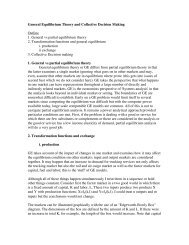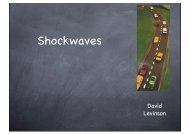multi-modal trip distribution: structure and application
multi-modal trip distribution: structure and application
multi-modal trip distribution: structure and application
You also want an ePaper? Increase the reach of your titles
YUMPU automatically turns print PDFs into web optimized ePapers that Google loves.
Levinson <strong>and</strong> Kumar<br />
________________________________________________________________________<br />
INTRODUCTION<br />
One of the components of travel dem<strong>and</strong> models is the estimation of the rate of decay with<br />
distance (or time) from an origin: the greater the separation between an origin <strong>and</strong> destination,<br />
the lower the propensity to make the <strong>trip</strong>. As time is the key indicator of separation in the utility<br />
of a <strong>trip</strong> maker, <strong>and</strong> travel time <strong>and</strong> <strong>trip</strong> quality vary by mode, the decay function is expected to<br />
be different for different modes. Not only do travel speeds vary by mode, but the choice of mode<br />
also partly influences locational decisions <strong>and</strong> individual willingness to make <strong>trip</strong>s of certain<br />
lengths. For instance, households wanting to use transit (heavy rail in particular) are more likely<br />
to locate along major transit facilities. However, conventionally, <strong>trip</strong> <strong>distribution</strong> functions are<br />
estimated for automobile <strong>trip</strong>s only <strong>and</strong> applied to <strong>trip</strong>s by all modes. The main justification for<br />
this procedure is that more than 80% of all <strong>trip</strong>s are made by privately owned vehicles <strong>and</strong><br />
specific treatment of transit <strong>and</strong> other modes is not expected to improve model performance<br />
significantly. However, with the emerging concern with the environment in recent years, <strong>and</strong> the<br />
response of managing travel dem<strong>and</strong>, local <strong>and</strong> state planning jurisdictions are grappling with a<br />
need to evaluate the feasibility of introducing High Occupancy Vehicle <strong>and</strong> transit facilities. It<br />
becomes important, therefore to explicitly account for different <strong>distribution</strong> characteristics of<br />
modes other than SOV. This research hopes to fill this gap by estimating a <strong>multi</strong><strong>modal</strong> <strong>trip</strong><br />
<strong>distribution</strong> function for the metropolitan Washington region. In addition, an <strong>application</strong> of the<br />
model to the evaluation of <strong>multi</strong>-<strong>modal</strong> networks is described.<br />
Use is made of afternoon peak period transportation planning models developed by the<br />
Montgomery County Planning Department (MCPD) over the past few years ( 1-4 ). Key elements<br />
of the model <strong>structure</strong> include segmentation of <strong>trip</strong> purposes by direction, which permits<br />
accounting for chained <strong>trip</strong>s; peak hour factoring as a function of congestion between <strong>and</strong> origin<br />
<strong>and</strong> destination; the <strong>multi</strong>-<strong>modal</strong> gravity model for <strong>trip</strong> <strong>distribution</strong>, described here; <strong>and</strong>, the<br />
feedback of travel time outputs from assignment into <strong>distribution</strong> to ensure travel time<br />
consistency through the model chain. Travel time feedback, along with <strong>multi</strong>-<strong>modal</strong> <strong>distribution</strong>,<br />
________________________________________________________________________<br />
December 17, 1996 2







